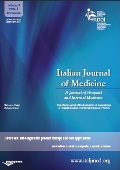Reviews
24 December 2013
Vol. 7 No. s8 (2013): The new oral anticoagulants in the Internal Medicine clinical practice
Direct oral anticoagulants in real practice: which doses for which patients. Limitations and bleeding risk compared to vitamin K antagonists

Publisher's note
All claims expressed in this article are solely those of the authors and do not necessarily represent those of their affiliated organizations, or those of the publisher, the editors and the reviewers. Any product that may be evaluated in this article or claim that may be made by its manufacturer is not guaranteed or endorsed by the publisher.
All claims expressed in this article are solely those of the authors and do not necessarily represent those of their affiliated organizations, or those of the publisher, the editors and the reviewers. Any product that may be evaluated in this article or claim that may be made by its manufacturer is not guaranteed or endorsed by the publisher.
913
Views
793
Downloads






